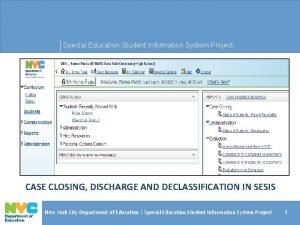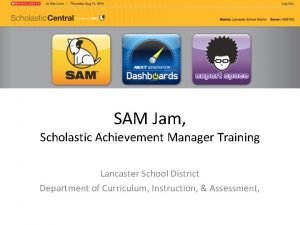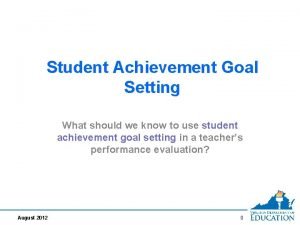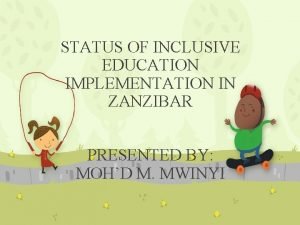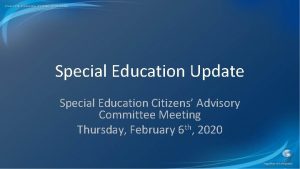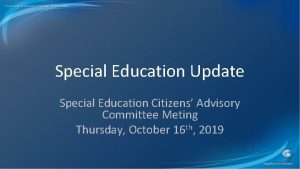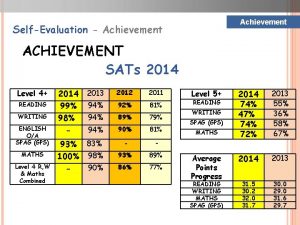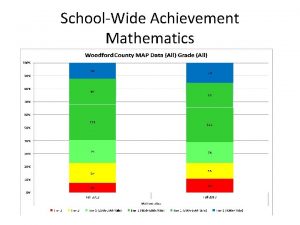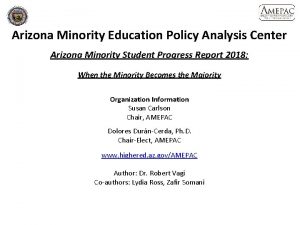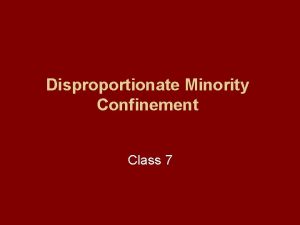Minority Student Achievement Advisory Committee Special Education Advisory














- Slides: 14

Minority Student Achievement Advisory Committee & Special Education Advisory Committee Positive Behavioral Interventions & Supports (PBIS) November 20, 2019 John Lody, Director Diagnostic and Prevention Services Stefanie La. Polla, Supervisor Multi-Tiered System of Supports

Content and Learning Intentions 1. Overview of Positive Behavioral Interventions and Supports (PBIS) 2. Established model to support PBIS implementation 3. Professional learning opportunities for school staff and PBIS coaches 4. Data used to drive decision-making and support 5. Resources to promote equitable practices

Overview of PBIS School-wide PBIS: A systems approach for establishing a safe, positive, and supportive learning environment to promote social, behavioral, and academic success for all students. Evidence-based features of school-wide PBIS ● ● ● Prevention & Intervention Define and teach positive expectations Acknowledge positive behavior (Feedback) Arrange consistent and equitable consequences for problem behavior Ongoing collection and use of data for decision-making Administrative leadership – Team-based implementation (Systems that support effective practices)

PBIS Tier 1 Primary Prevention for ALL School/Classroom. Wide Systems for All Students, Staff, and Settings ~5% Tier 3 Tertiary Prevention for Few Individualized Systems for Students with High-Risk Behavior ~15% Tier 2 Secondary Prevention for Some ~80% of Students Group Systems for Students with At-Risk Behavior

LCPS Office Referral Data National Office Referral Data (6+ Referrals) (2 -5 Referrals) (0 -1 Referrals)

LCPS School Improvement Plans Schools are asked to review their data as part of a Comprehensive Needs Assessment and identify areas of priority for inclusion within their School Improvement Plans

PBIS and School Improvement Systems and Strategies to: • increase positive school climates • increase safe, inclusive, and supportive learning environments • increase academic engagement

Division Support Established Model of Support Provides support to coaches and school teams through site visits, coaches meetings, professional learning, and collaboration with various LCPS offices and departments School PBIS Team Shares data to support student success; develops and implements actions to support school-wide positive behavior; engages families and communities in PBIS External & Internal Coaches at each school Facilitates school PBIS team in analyzing data trends, engaging in data based decision-making and developing and implementing action steps to support schoolwide positive behavior

Professional Learning Opportunities ● Training is provided at the division, regional/cluster, and school level ● PBIS coaches meetings are held four times per year to support implementation ● PBIS coaches, teams, and school leaders receive strategic support through site visits by the PBIS Coordinator and the PBIS Consulting Teacher ● Professional learning is provided on topics such as : ○ PBIS New Team Training ○ PBIS New Coach Training ○ Check In/Check Out ○ Implementing and Evaluating Interventions to Support Students ○ Classroom Systems

8 Classroom System Practices 1. 2. 3. 4. 5. 6. Arrange Orderly Physical Environment Employ Active Supervision Define, Teach Classroom Routines Define, Teach, Acknowledge Rules & Expectations Provide Specific Praise for Behavior Continuum of Response Strategies for Inappropriate Behaviors (Error Correction) 7. Class-Wide Group Contingency 8. Provide Multiple Opportunities to Respond Adapted from MO Classroom PBIS

Goal of Classroom Systems Create and maintain a culturally affirming classroom culture and genuine positive relationships, which leads to increased engagement, academic performance and overall well-being for students and staff

MTSS Data Analytics Tool Qlik Violation Report Annual Climate Surveys Data Driven Decision-Making and Support

Resources to Promote Equitable Practices 1. Classroom Systems Snapshots 2. Cultural Responsiveness Field Guide 3. Reflective Considerations for Discipline 4. Equitable Classroom Practices Observation Tool

Resource MTSS Website: https: //sites. google. com/lcps. org/mtss/home-mtss
 Sesis help desk
Sesis help desk Special education student information system
Special education student information system Working with models
Working with models Yash pal committee report 1993
Yash pal committee report 1993 Trade union advisory committee
Trade union advisory committee Robert kerzner
Robert kerzner Aviation rulemaking advisory committee
Aviation rulemaking advisory committee Student achievement manager login
Student achievement manager login To assess achievement at the end of instruction is
To assess achievement at the end of instruction is American student achievement institute
American student achievement institute Student achievement goals
Student achievement goals American student achievement institute
American student achievement institute Achievement of inclusive education in zanzibar
Achievement of inclusive education in zanzibar Higher education achievement report
Higher education achievement report Mudliyar commission
Mudliyar commission
